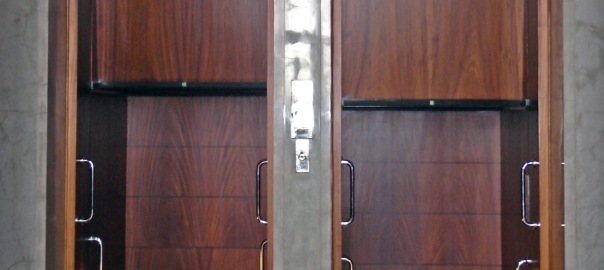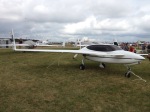It’s June 30, 2007. You are standing outside the doors to the terminal at Glasgow International Airport. It’s 3:11 in the afternoon. It’s raining, a little bit. The ground is wet as cars drive past.
Then, all of a sudden, a dark green Jeep Grand Cherokee approaches. It’s going too fast. It shouldn’t be going that fast. There are two men inside. It’s headed straight at you, straight at the terminal. There are so many people inside.
You hold your ground. That’s your job, actually. You dig in as the jeep approaches at 30 miles per hour. It’s not gonna stop.
It’s not getting past you though. It hits you, stops immediately, and it’s on fire. The smell of gasoline is everywhere. The driver gets out. He’s on fire too, and starts walking toward the terminal. Someone inside puts him out but makes sure he stays down. Doctors will do everything they can to save him but he’ll die of his burns a few days later.
The passenger gets out and someone — a hero — tackles him to the ground. He’ll serve at least 32 years of a life sentence for his part in this. You’re a hero too. You stopped that jeep with its cans of gas and cylinders of propane from entering the terminal. But you won’t get the Queen’s Gallantry Medal or the Commendation of Bravery, like those other people. But you’re not a person, are you?
You are a post in the ground, in front of the door. Your job is to keep the bad guys in speeding cars and trucks out.
You, are a bollard.
This is Matt Croydon and you are listening to The Tinycast.
The first things to be called bollards were posts on ships and wharves where they docked. Some of the earliest surviving references in literature describe their use on whaling vessels. Like this passage from The Arctic Regions and the Northern Whale-fishery from 1849, originally published in 1820:
“To retard, therefore, as much as possible, the flight of the whale, and to secure the lines, it is usual for the harpooner to cast one, two, or more turns of the line round a kind of post, called a bollard, which is fixed within ten or twelve inches of the stern of the boat for the purpose. Such is the friction of the line, when running round the bollard, that it frequently envelops the harpooner in smoke; and if the wood were not repeatedly wetted, would probably set fire to the boat.”
On land, bollards were sometimes repurposed cannon, their barrels buried in the ground. In the early 18th century they began to be used in cities for traffic management and to protect buildings against damage from carriages.
Today, bollards are everywhere, and they take many forms. You might see them on a construction site: skinny orange plastic posts on a rubber base or the bigger kind that almost look like a barrel. They can separate bike lanes from traffic. You might see a single bollard in the middle of a bike path making sure that bikes can pass but cars can’t. Sometimes they provide lighting along a foot path or are lit with signage. You might see them in parking lots, protecting things from wayward bumpers.
One of my favorite things that bollards do well is play a critical role in something called site security. Site security is basically keeping a building or campus safe from threats. It’s also about reducing the risk of terrorist attacks by car or truck.
It’s time for a little site security 101.
One way to think of site security is to break things up in to six zones from the outside in. Think of it like a castle with a moat, a wall, and a fortified keep in the middle.
Zone 1 is the neighborhood outside. You usually can’t control things here but you can work with businesses, community groups, and governments to affect stuff like traffic flow or zoning laws.
Zone 2 is your standoff perimeter. This is where you draw the line and say that no unauthorized vehicles are going to get past. This is where you make the calculation that if an explosive in a car or truck goes off, the buildings you’re protecting will be safe enough.
The perimeter can be made from walls to fences, planters, light posts, reinforced benches, and bollards, among other stuff. A well designed perimeter can be made more open and inviting with some well-placed bollards and other things that provide enough protection with a more open feel.
Zone 3 is site access and parking. This is another spot where you can use bollards to control the flow of traffic. Retractable bollards can be used to protect entrances from ramming while allowing authorized vehicles through. Retractable or collapsible bollards can also be used in pedestrian areas that might require emergency vehicle access.
Zone 4 is your site, or the area between your standoff perimeter and your buildings. The bigger this zone is the better protected you are from explosions at the perimeter. This is an opportunity to have a big public plaza, a visitors center, outdoor art, a park or a café. Benches, bollards, planters, water features, and landscaping can be used to restrict vehicle access while keeping things open and inviting.
Zone 5 is your building envelope: the outside of the buildings you’re protecting and things like air vents and entrances.
Zone 6 is management and building operations. This can be anything from moving higher risk areas deep inside buildings to surveillance and security patrol planning.
All bollards aren’t created equal. The most elite bollards are certified K12 by the Department of State. They might be buried deep in the ground or have elaborate shallow roots in urban settings. These can stop a 15,000 pound flatbed truck at 50 miles per hour. They can only allow the front of the truck bed a single meter past the bollard. That’s stopping power.
I went looking for bollards in downtown and suburban Austin, Texas. Needless to say I found a ton. I put together a photo gallery at tinycast.in/bollards. I ended up at one of the more complex site designs in Austin:
I’m outside the Texas State Capitol grounds at the standoff perimeter. There are beautiful flowers, a low wall and an ornate gate with bollards in front of it. Just to either side of me is a driveway with retractable bollards so cars can exit. The Capitol grounds also maximize the distance from the street to the building. There are paths and shade and statues and plaques. This is both successful site security design and a beautiful public space.
Overall I think bollards do a pretty excellent job at all the jobs that they do. They are definitely pretty open and pedestrian and bike friendly. The bang for buck on them usually makes a lot of sense too.
I’ll bet you see them everywhere you go today today.
You’ve been listening to The Tinycast, the place where you’re not at all surprised to hear from an anthropomorphized architectural element.
Music is by the mysterious Breakmaster Cylinder, whose beats are so solid they’re rated K12. You can find them on SoundCloud, Bandcamp, or protecting street corners everywhere.
Today’s show is brought to you by audible.com where you can get a free audiobook and a 30 day free trial by visiting audible.tinycast.in. If you’re looking for books set at sea, check out Master and Commander, the first book in the Aubrey-Maturin series by Patrick O’Brien. Or try one of the Richard Bolitho novels by Douglas Reeman who writes as Alexander Kent. That’s right, even the ad copy is pedantic here. Get your free audiobook and your 30 day free trial at audible.tinycast.in.
As always, you can find tons of links to further reading at tinycast.in. You can find us in iTunes, soundcloud.com/tinycast, and hopefully wherever you are. We’re on Twitter @thetinycast, and I’m @mc. You can see a photo gallery of all the bollards I encountered at tinycast.in/bollards.
Episodes are also available at the Public Radio Exchange, PRX.org.
Further Reading
- More about the Glasgow Airport attack.
- The Whole Building Design Guide has some amazing resources.
- Effective Site Security defines the zones well.
- There are pages about crash resistant bollards and non-crash resistant bollards.
- The Protective Design Center has information about bollard certification.
- FEMA released a series of publications after September 11, 2001. Site and Urban Design (FEMA 430) contains several case studies of vehicle-borne explosives and is a good supplement to the Whole Building Design Guide material.
- Books
- Trivia
- This is the first episode to feature a cold open. It’s like Law & Order: Architecture and Design Unit







